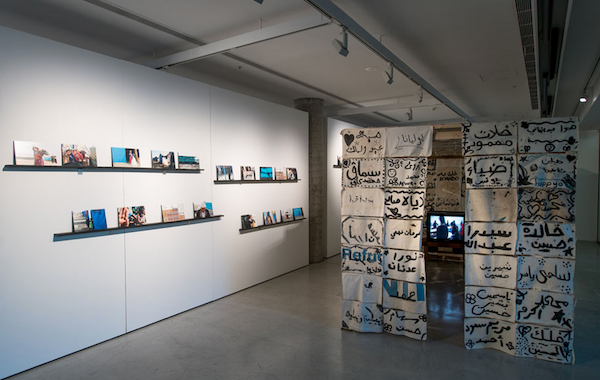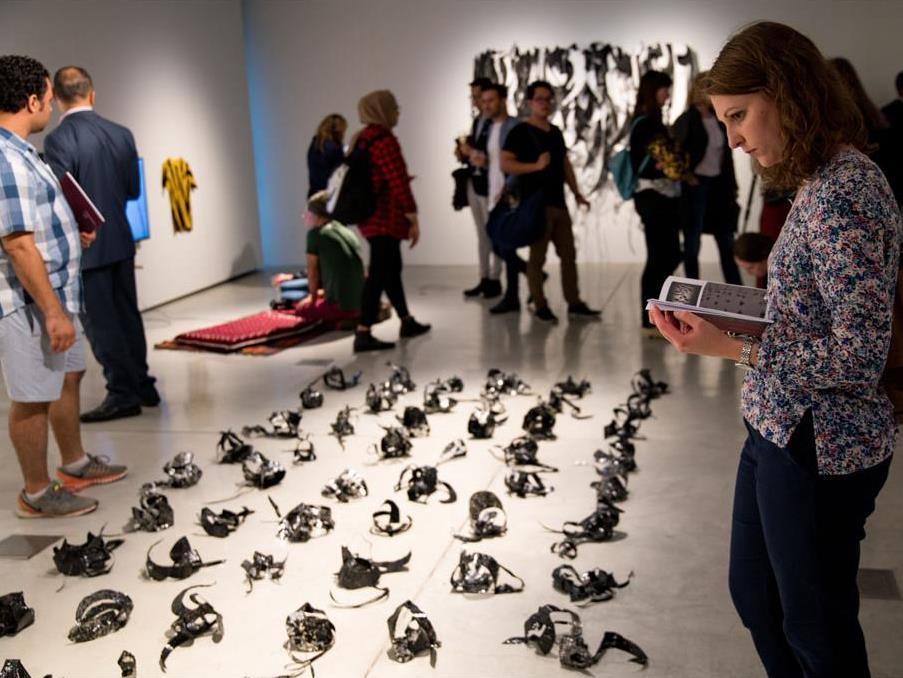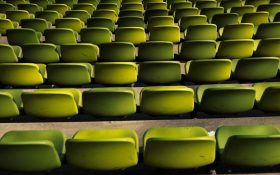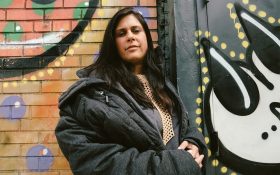“The Invisible” 2017. Curated by Abdul Karim Hekmat, 3 October—24 November 2017 at UTS Gallery. Photo credit: David Lawrey
Despite being fed images and stories of refugee crises from across the world, the charting of the trauma, rejection and loss inherent in displacement has largely been obscured and silenced. The Invisible, consisting of works by refugee artists and curated by refugee journalist and photographer Abdul Karim Hekmat, offers glimpses of these all-too-often overlooked refugee experiences.
Drawn directly from his witnessing of a fatal bomb blast in Kabul, which killed 90 Hazara protestors, Elyas Alavi’s works reveal the confusion and injustice in the aftermath of violent persecution. In the film installation Mohammad Jan (2016-17), a family who lost their son to the protest recount the administrative process of recovering his body. Alavi uses rugs and floor cushions before a television to position the viewer in a shared space with the subject. This inviting setting extends the recorded Mise-en-scène into the gallery itself, juxtaposing the cognitive divide that so often distances the suffering of those in far away and unfamiliar places.

Installation view of Elyas Alavi’s work Mohammad Jan (2016-17) at UTS Gallery, Sydney; Courtesy the artist, Photo David Lawrey
Alavi’s Fading Faces (2017) is a portrait series on glass depicting the Hazara protestors, which wrestles with notions of human fragility, splitting the living colour of each painted face from its stark outlines in shadow on the wall. Representing faces on glass highlights the vulnerability of a life in persecution, its three dimensionality also hinting at Western ignorance – the shadows of these faces, proof of substance and presence, disappear when their stories are kept in the dark.
Avan Anwar magnifies the loss of cultural identity in Dancing Letters and Displacement (2016), in which Persian poetry is scrunched up and strewn on the gallery floor. The installation is a physical representation of the links between language and sense of self, and the ramifications of their rupture.

Installation view of Avan Anwar’s Dancing Letters and Displacement (2016 )- central and rear wall – at UTS Gallery, Sydney; Courtesy the artist; Photo David Lawrey
The preciousness of a name, this most basic expression–and possession–of identity, is made profoundly clear in Rushdi Anwar’s The Notion of Place and Displacement (2017). Anwar provides a window into the nature of fractured identity through the reconstruction of a UNHCR tent covered in the autographs of children. There is resistance in these signatures – resistance against the processes, which redefine and reduce displaced persons into numbers, instead codifying them by status and circumstance.

Installation view Rushdi Anwar’s The Notion of Place and Displacement (2017) – right – and photo series Unprotected (2017) – left; courtesy the artist; photo David Lawrey
The potential dangers and damages of seeking asylum in Australia are embodied in Unprotected (2017), Rushdi Anwar’s series of battered photographs, printed onto board and sent as ‘postcards’ from Kurdistan to Melbourne. They bear the physical scars of transit, mere echoes of the human experience of transnational movement.
Meanwhile, Kadim Ali’s Untitled (from The Arrivals series, 2016) illustrates the systematic demonisation of asylum seekers in Australia’s political rhetoric. Ali’s practices in miniature and mural painting meet in this sinuous portrayal of an overcrowded vessel on turbulent seas. It begs the question: who is more monstrous, the demons aboard in life jackets, or the beasts waiting to receive them in the waters?

Detail of Kadim Ali’s Untitled (from The Arrivals series, 2016); Courtesy the artist and Milani Gallery. Photo credit David Lawrey.
The hardship lying ahead for such ‘boat people’ can be found in curator Abdul Karim Hekmat’s video series Nauru Refugee Voices (2017), which reveals the dehumanizing effects of Australia’s disturbing policies of offshore detention that keep the refugees in its care out of sight.
From the violence and insecurity of warfare and ethnic persecution, through to the stress of statelessness, cultural upheaval and the hostility a new ‘home’ country, The Invisible is a powerfully illuminating reminder of the extent that refugee experiences are hidden, providing worthwhile insight for those of us who have never faced such enduring trauma and loss.
The Invisible
Artists: Khadim Ali, Elyas Alavi, Avan Anwar, Rushdi Anwar and Abdul Karim Hekmat.
UTS Gallery, Sydney
3 October – 24 November
This review of The Invisible is published in support of UTS Gallery Student Writing Program.
The exhibition is accompanied by an extensive print catalogue, public programs and schools workshops supported by grant funding from Create NSW.





